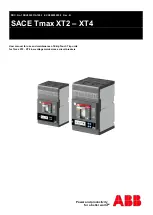
38
44
Bas ic functions for all control modules
Charging of the Capacitors
Closing and trip capacitors of the CM are charged when CM is applied to the auxiliary power supply. The charged
closing capacitors correspond with the charged springs of a conventional circuit breaker. After the failure of
auxiliary power supply any pending trip or any trip command arriving to the CM up to 30s after failure of auxiliary
power supply will be executed.
Ready-LED and Ready-Relay Output
While charging the capacitors, the Ready-LED blinks. When the capacitors are charged the Ready-LED is
continuously lit and the Ready-relay output contact is closed. With a blinking or extinguished Ready-LED, the
Ready-relay output contact is open. The Ready-relay output can be used as a permissive, such as the release
condition for a breaker control.
Malfunction-LED and Malfunction-Relay Output
If the CM detects an internal or external malfunction, the Malfunction-LED will blink according to the type of
malfunction (see the “Signalling” chapter of this manual). At the same time the Malfunction-relay output contact
will close. In this way a CM-Malfunction state can be transmitted to an alarm or SCADA system. In the case of a
malfunction the Ready-LED is extinguished and the Ready-relay output contact is opened. The Malfunction-relay
output contact is closed if the CM is powered off.
Switching the ISM On and Off via the Dry Contact
Inputs of the CM
The ISM can only be closed electrically via the CM. Dry contact inputs are available on all CMs for
close and trip operations. Each of these inputs can be connected with one or more parallel-switched dry
contacts. Under no circumstances shall external voltage be applied to these inputs as this will destroy the
CM.
Electrical Clos ing Lock-Out
When the ISM manual trip hub is rotated to the locked position, an internal microswitch prevents close operation
of the breaker. As the hub is rotated counter-clockwise, the ISM is mechanically tripped (if closed) followed by the
microswitch disengaging the actuator connections. This prevents the breaker from closing until the trip hub is
rotated back to the unlocked position.
Summary of Contents for ISM Shell_2 Series
Page 2: ...2...
Page 6: ...6 1 THIS PAGE INTENTIONALLY LEFT BLANK...
Page 7: ...7 Introduction 1...
Page 12: ...12 1 THIS PAGE INTENTIONALLY LEFT BLANK...
Page 13: ...13 Receiving Handling and Storage 2...
Page 19: ...19 Ins tallation 3...
Page 36: ...36 3 THIS PAGE INTENTIONALLY LEFT BLANK...
Page 37: ...37 Switching and Control Functions 4...
Page 41: ...41 Commiss ioning Maintenance 5...
Page 44: ...44 5 THIS PAGE INTENTIONALLY LEFT BLANK...
Page 45: ...45 Signalling 6...
Page 49: ...49 Special Applications Fast Switching 6...
Page 53: ...53 Product Line 7...
Page 55: ...55 Dimens ions and Weights 8...
Page 61: ...61 8 Mating part with interlocking lever Interlockingshaftwithmountedinterlockinglever...
Page 62: ...62 Circuit Diagrams 9...
Page 63: ...63 ISM15_Shell_2 with CM_1501_01 9...
Page 64: ...64 ISM15_Shell_2 with CM_16_1 9...
Page 65: ...65 9 THIS PAGE INTENTIONALLY LEFT BLANK...
Page 66: ...66 Technical Data 10...
Page 71: ...71 10 THIS PAGE INTENTIONALLY LEFT BLANK...
Page 72: ...72 Regulations and Ambient Conditions 11...
Page 74: ...74 Legal Information 12...
Page 77: ...77 12 THIS PAGE INTENTIONALLY LEFT BLANK...
Page 79: ...79 Date 12...
Page 80: ...80 Date 12...
Page 81: ...81 Date 12...














































